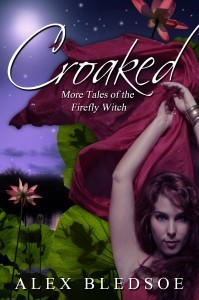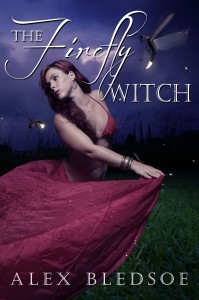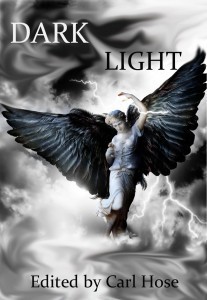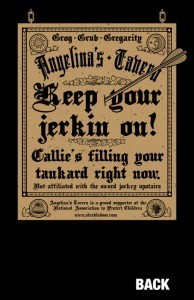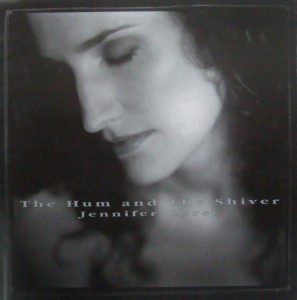Alex Bledsoe's Blog, page 26
July 2, 2012
Trailer #2 for Wake of the Bloody Angel
To commemorate tomorrow’s release of Wake of the Bloody Angel, the fourth Eddie LaCrosse novel, here’s the second book trailer: longer, with different music (by Laura Powers) and a different slant on the story. Hope you enjoy!
June 30, 2012
Firefly Witch news (includes a freebie!)
The new Firefly Witch e-book chapbook collection, Croaked: More Tales of the Firefly Witch, is now available for only $2.99.
Also, from now through Monday, June 2, 2012, the first Firefly Witch collection is available for FREE on Amazon. So if you’re curious about this new character and her world, there’s no better way or time to check it out.
June 25, 2012
A new free song download
After the amazing response to the free download of Jennifer Goree’s song “The Hum and the Shiver” (still available here), I’m delighted to offer another freebie.
“Pirate,” the song featured in the book trailer for Wake of the Bloody Angel, is now available on the novel’s book page. Scroll down a bit, and you’ll see the words FREE DOWNLOAD.
Thanks to my wonderful friend Jen Cass, singer and songwriter of this marvelous tune, for allowing me to share it. It’s from her album Skies Burning Red.
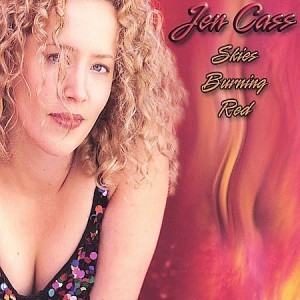
Skies Burning Red
If you go to the book page for The Hum and the Shiver here on my website and scroll down, you’ll see the words FREE DOWNLOAD.
Click on the link, and you’ll get the entire song “The Hum and the Shiver,” as featured in the book trailer. If you’re curious, you can also go to this blog post and read about how Jennifer and the Tufa are inextricably linked.
Thanks to Jennifer Goree for granting permission to share her marvelous song.
June 18, 2012
Short story in new anthology
My short story, “The Cut,” is available as part of Dark Light, an anthology edited by Carl Hose to benefit the Ronald McDonald House Charities. Please consider picking up a copy; the list of contributors is pretty impressive, and it’s for a good cause.
June 11, 2012
Maria Scholl, the overlooked great science fiction heroine
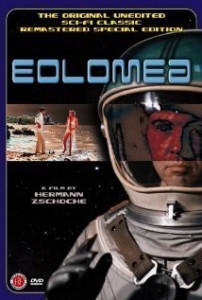
The DVD cover
A while back I wrote about Meg Coburn (Mira Sorvino) of The Replacement Killers, the forgotten great action heroine. Now I’m spotlighting Maria Scholl, the overlooked great science fiction heroine.
Scholl, played by Cox Habbema, is one of the main figures of Eolomea, a 1972 East German (i.e., Soviet-era Communist) SF film directed by Hermann Zschoche. In a nonspecific future, spaceships traveling to and from space station “Margot” begin to vanish. Professor Scholl, head of the space program’s ruling council, leads the investigation, first on earth and then in space. It dovetails with the story of Dan Lagny, a space pilot doing thankless time on an asteroid station, who also has a past romantic relationship with Scholl.
Like Meg Coburn, much of what makes Maria interesting are the things she doesn’t do. As Erich Kuersten says on the blog Acidemic, she is, “shrewd, kind, and able to have a romance with the main cosmonaut Dan (Ivan Andonov) without it clouding her judgment or weakening her authority. She doesn’t overreact or have womanly issues, or pine for something ‘real’ in her life, something ‘better than command… like a child and a family,’ the way she would have to in the U.S. [at the time the film was made.]“ When another council member suggests that her presence on the rescue mission might, ahem, distract the all-male crew, she responds easily with, “The boys have had to get used to many things. They can get used to one more.” And that scene is the only one where it’s implied that her status as a woman is in any way an issue. In everything else, her competence, authority and intelligence are simply assumed.
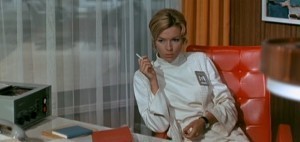
Dr. Scholl at work…
And make no mistake, she’s a woman. When shown in flashbacks on the vacation where she meets Dan, she’s as free with her sexuality and attractiveness as any other woman on holiday might be. She wears tight shorts, she flirts, and in the one flashback scene where her job does arise, she wears a bikini on a beach while discussing Dan’s duty assignment. The implication is that women in this version of the future don’t have to choose between career and personal life: everything is open to them, and more importantly, no one expects them to pick one or the other.

…and at play, with Cosmonaut Dan.
In fact, Eolomea as a whole doesn’t do what you might expect. The space council is an international organization, and you see more faces of color that you’d ever encounter in an American SF film of the era (or heck, even now). The moments that would seem obligatory, such as the first declaration of love between Maria and Dan, or their reunion scene toward the end, simply aren’t there. The scenes that do exist imply these other scenes happen, but it’s as if the editors (and they’re ruthless: the film is only 80 minutes long) decided that they were too obvious to leave in. The antagonist might look like Blofeld from You Only Live Twice, but his nefarious plan is really…well, I don’t want to spoil everything.
East German cinema isn’t exactly known for its masterpieces, and in the popular Western mind, Soviet-era science fiction begins and ends with Solaris. But Eolomea deserves to be more appreciated, and thanks to a great DVD release (and its availability through Netflix), now it can be.
June 9, 2012
Show your love for Eddie (and a good cause, too)!
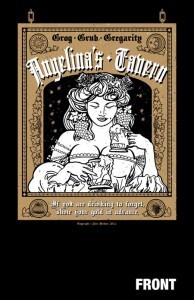
So, as promised, here’s my big announcement. I’m joining Joe R. Lansdale, Jonathan Lethem, Nick Hornby, Richard K. Morgan Chuck Klosterman, Dennis Lehane and three of my personal heroes–Bruce Springsteen, Charles de Lint, and Andrew Vachss–at Novel Tees. It’s a literary t-shirt shop where all profits go to Protect, a lobby for legislation to protect children from physical, sexual, and emotional abuse. And when Andrew Vachss signs off on this sort of organization, you can be sure it’s the real deal.
The shirt, heralding the charms of Angelina’s Tavern, is available for discount pre-order right now. As the site says, shirts are SCREEN-PRINTED (not some cheap, one-off photo print) on Anvil 100% organic cotton T-shirts. I proudly wear the Mama’s Restaurant shirt (from Vachss’s Burke novels), so I can vouch for their quality.
As I said, I get nothing from this; all profits go to Protect. But you do: in addition to getting an awesome shirt, if you post a photo of yourself wearing it, I’ll send you a free signed copy of the Eddie LaCrosse book of your choice! So pass the word, share on your social networks, and let the world know about Angelina’s Tavern.
June 4, 2012
Sword up vs. sword down
To general readers (i.e., those who don’t read one genre exclusively), “fantasy” means warriors, sorcerers, castles and dragons. The omnipresence of Joseph Campbell, in the wake of George Lucas, has added the core story idea of the naive young hero, sword raised as a beacon of everything that’s just and right, preparing to go into battle. You can see the quintessential image of this on the original Star Wars poster.

Artwork by the brothers Hildebrandt
The concept itself, though, probably goes back to King Arthur pulling the sword from the stone and to whatever prior folklore inspired it.
It’s certainly a primal idea. The sword aloft symbolizes courage, justice, and all the other positive aspects of a might-makes-right feudal society. Modern readers like it because it tells us that the person holding the sword, whether the unaware bastard son of a king or the farmboy who’s the new hope of the galaxy, has the kind of moral compass that will always guide that sword to the right mark. It points (no pun intended) toward a glorious future.
And yet, there’s an opposite idea that’s almost as powerful. And to me at least, a whole lot more interesting.
It’s the image of the warrior after the battle, sword down, surrounded by the bodies of the dead. He’s not young; often he’s depicted visually as grizzled and scarred. Far from being naive, he’s gifted with knowledge most of us would never want to acquire. He knows the cost of victory.
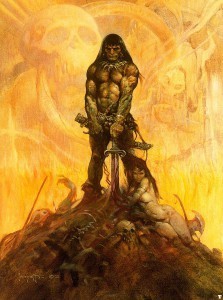
Conan, by Frank Frazetta.
As a writer, I find this image much more compelling, because it has dramatic depth. It carries its own history. Perhaps it’s because I’m middle-aged myself, but the idea of the naive young hero setting out on his adventures isn’t nearly as interesting as the battered semi-hero struggling to both defeat his enemies and hang onto his morals. (interestingly, that’s also a fair description of the classic private eye).
As youngsters first discovering fantasy, we respond to the figure closest to ourselves. We like the idea of the “average” kid being plucked from obscurity by a destiny s/he never knew existed: King Arthur, Luke Skywalker, Jim Hawkins, Lessa of Pern. It’s something we all hope also happens to us. But as adults, we recognize both the shallowness and the short shelf-life of such a character. We’ve seen real life tarnish the armor of too many ersatz shining knights.
Now, I’m not saying adults don’t enjoy Luke Skywalker, or that younger readers don’t appreciate Conan. Both are perfectly valid character archetypes. But I do think we appreciate them differently at different stages of our lives. It’s what makes fantasy so much fun to read, and to write.
At this stage of my own life, I’m still living them both. I read Treasure Island to my sons, and see them mentally and emotionally identify with Jim Hawkins. At the same time I enjoy books by my peers that deal with bitter, slightly shady characters struggling with their pasts, such as Kelly McCullough’s Broken Blade and Douglas Hulick’s Among Thieves. And of course I have my own Eddie LaCrosse, who has plenty of baggage of his own.
Who are your favorite stalwart young heroes (in the genderless sense of the word), and your favorite ones over thirty?
June 1, 2012
Special gift to fans of THE HUM AND THE SHIVER
If you go to the book page for The Hum and the Shiver here on my website and scroll down, you’ll see the words FREE DOWNLOAD.
Click on the link, and you’ll get the entire song “The Hum and the Shiver,” as featured in the book trailer. If you’re curious, you can also go to this blog post and read about how Jennifer and the Tufa are inextricably linked.
Thanks to Jennifer Goree for granting permission to share her marvelous song.
May 28, 2012
The real pirate of the Bloody Angel
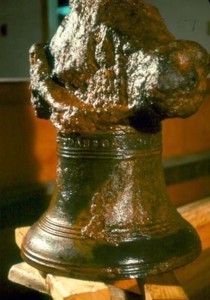
The bell from Black Sam's Whydah
When I began thinking about the next Eddie LaCrosse novel, sometime during the final stages of Dark Jenny, I knew I needed a simple hook for it. The previous books had them: The Sword-Edged Blonde came from the song, “Rhiannon,” Burn Me Deadly came from a mash-up of Kiss Me Deadly and the idea of dragons as nuclear weapons, and Dark Jenny was, of course, inspired by King Arthur. So what, I pondered, would be next?
At first I considered the idea of a DaVinci Code-ish (okay, really, a Foucault’s Pendulum-ish) mystery set in my made-up world. That immediately felt impractical, as it would require creating far more history, backstory and mythology than I felt the series could bear. I did try, though, creating a chain of clues for Eddie to discover, each one leading him to the next, in a globe-trotting adventure. But it quickly grew cumbersome, and untrue to the character’s noirish origins. So I downshifted to a more traditional treasure hunt, this time based on my lifelong interest in the Oak Island Money Pit (more on that in another blog post). That led me to the simple hook I needed: pirates.
But what pirates? Which pirate?
I wanted to base my pirates on real ones. And there were a lot of good ones out there. But I needed one who turned pirate for the right sort of reason, one that would inspire someone to hire Eddie to go after him.
And that led me to Black Sam Bellamy, and his ship, the Whydah, which went down in 1717.

The first-person account of the Whydah's rediscovery.
The Whydah stands as the only pirate ship whose wreck has been positively identified (her bell, with her name on it, was discovered in 1984; see above illustration). But the story of Black Sam is what really got my attention. He turned pirate not from greed or vengeance, but from love: he wanted to amass a fortune, then return to marry his Cape Cod girlfriend. That was the kind of hook on which I could hang an Eddie LaCrosse story.
Now, as with most initial ideas, the story became its own thing in the telling. Black Edward might do some of the same things as his inspiration Black Sam, but his reasons are eventually revealed to be completely different, as is his ultimate fate. But using the real man as the basis for the story continues something I established with my first Eddie novel, namely to find fantasy analogues for elements of real life whenever possible (that’s why, in that first novel, a horse gets a parking ticket).
So Wake of the Bloody Angel, while it moves into a new setting (see this blog post for more information about that) and introduces new characters, also follows the series’ unspoken (and extremely loose) rules. Because the fun of writing them is in giving readers exactly what they expect, but in ways they don’t anticipate. That way it stays fresh for you, and me.
May 26, 2012
The Music of the Firefly Witch
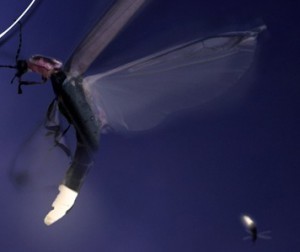 Back when I first wrote the stories that comprise volume one of The Firefly Witch tales, I also discovered the use of music to set the mood for writing. I know from talking to other writers that it’s a common thing now, and probably was back then–Stephen King blasted AC/DC when he was working, for example. But with no internet to connect me with other authors, I not only discovered it on my own, but thought perhaps I was unique.
Back when I first wrote the stories that comprise volume one of The Firefly Witch tales, I also discovered the use of music to set the mood for writing. I know from talking to other writers that it’s a common thing now, and probably was back then–Stephen King blasted AC/DC when he was working, for example. But with no internet to connect me with other authors, I not only discovered it on my own, but thought perhaps I was unique.
The two songs I associated with Ry and Tanna Tully were specifically about their relationship, and more specifically about how Ry saw his girlfriend/wife. This was sort of inevitable, given that I’d decided to tell the stories from Ry’s point of view. In a sense, that choice freed me from a level of objectivity that would’ve been hard to maintain. I couldn’t constantly reiterate how beautiful Tanna was, or keep describing that beauty in detail, without it becoming tedious. However, it was a snap to describe how Ry saw her and felt about her, because it established the stories’ central relationship in a way that an objective, third-person perspective never could. And it really didn’t matter if Tanna was the most attractive woman in the world; what mattered was that Ry thought she was. As I revise the stories for the next volume, I’m reminded of the wisdom of that decision. I’d like to say it was a conscious choice, and in some ways, it was. But there was also a healthy dollup of beginner’s luck.
The first song that connected itself to the stories (and I use that phrase deliberately; I never set out to find songs, they just appear and resonate) was “Spooky,” released by the Classics IV in 1968. First, the song itself is brilliant: there’s a sense of wind through bare trees in the production, and the vocals are simply and fun. If you pay close attention to the end of the story, “The Chill in the Air Wakes the Ghosts Off the Ground,”* you’ll catch the pretty blatant shout-out to the song.
The other song, 1985′s “And She Was,” is by the Talking Heads. Ironically, I’ve never been a huge fan of David Byrne, but this song has a joyousness that goes beyond the arrogant smugness of most of his work. The story, possibly apocryphal, is that Byrne wrote the song about a girl who liked to take LSD in a field next to a Yoo-Hoo factory. But whatever the inspiration, it’s always felt to me like a man delighted with a girl’s quirks, and that’s certainly how Ry feels about Tanna; hell, he’d have to, to put up with them.
These songs let me quickly access the mood I’m after when I’m writing. And, now that I’m revamping and revising these Firefly Witch stories, that’s become an incredibly crucial thing. I wrote the original versions of most of these stories fifteen years ago, when both the world and this writer were very different; the music lets me reconnect with how I originally felt about them, and why I felt their stories were worth telling.
*the title of this story comes from a slightly misheard lyric in “Harvest Moon” by the awesome Jason and the Scorchers

